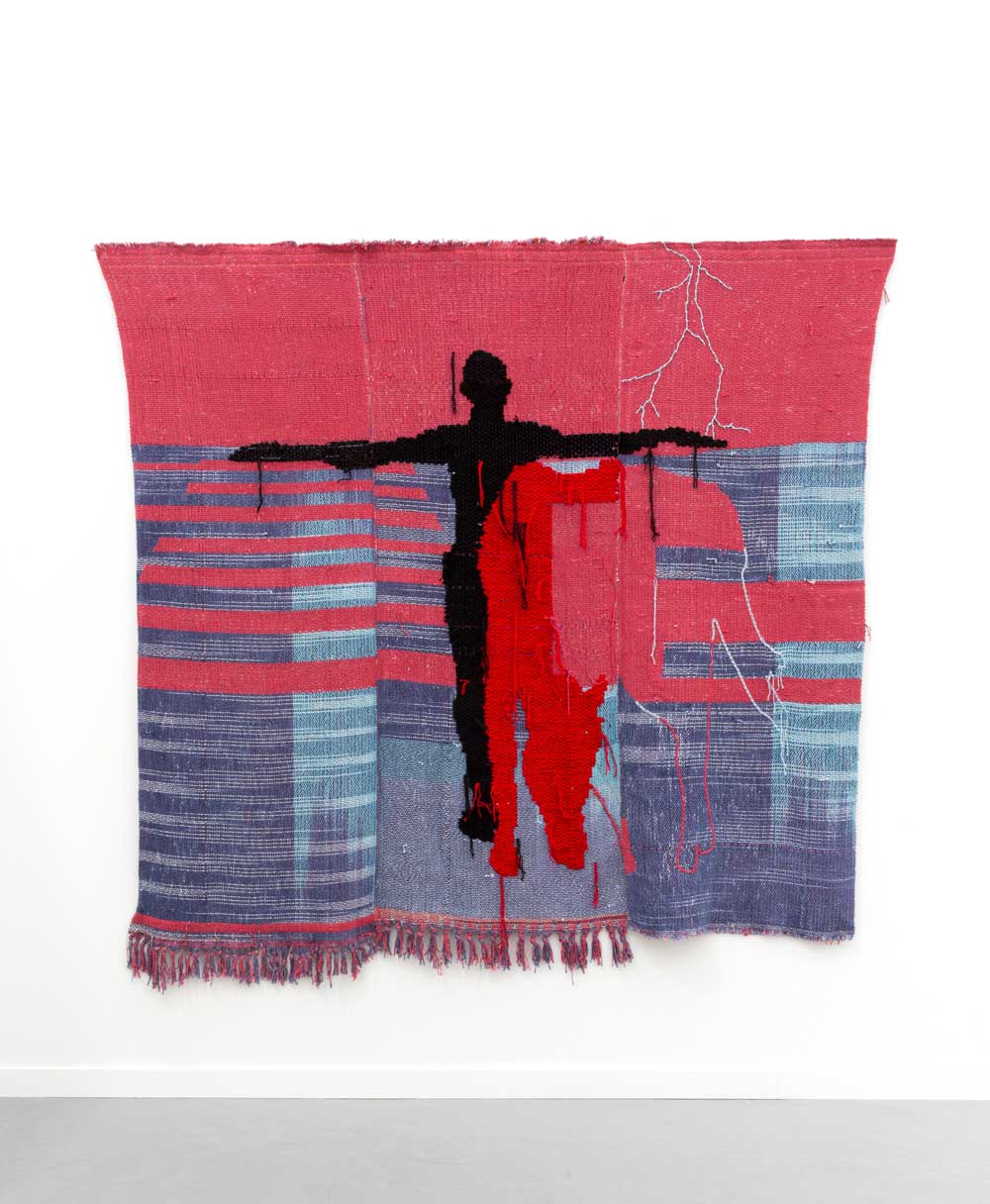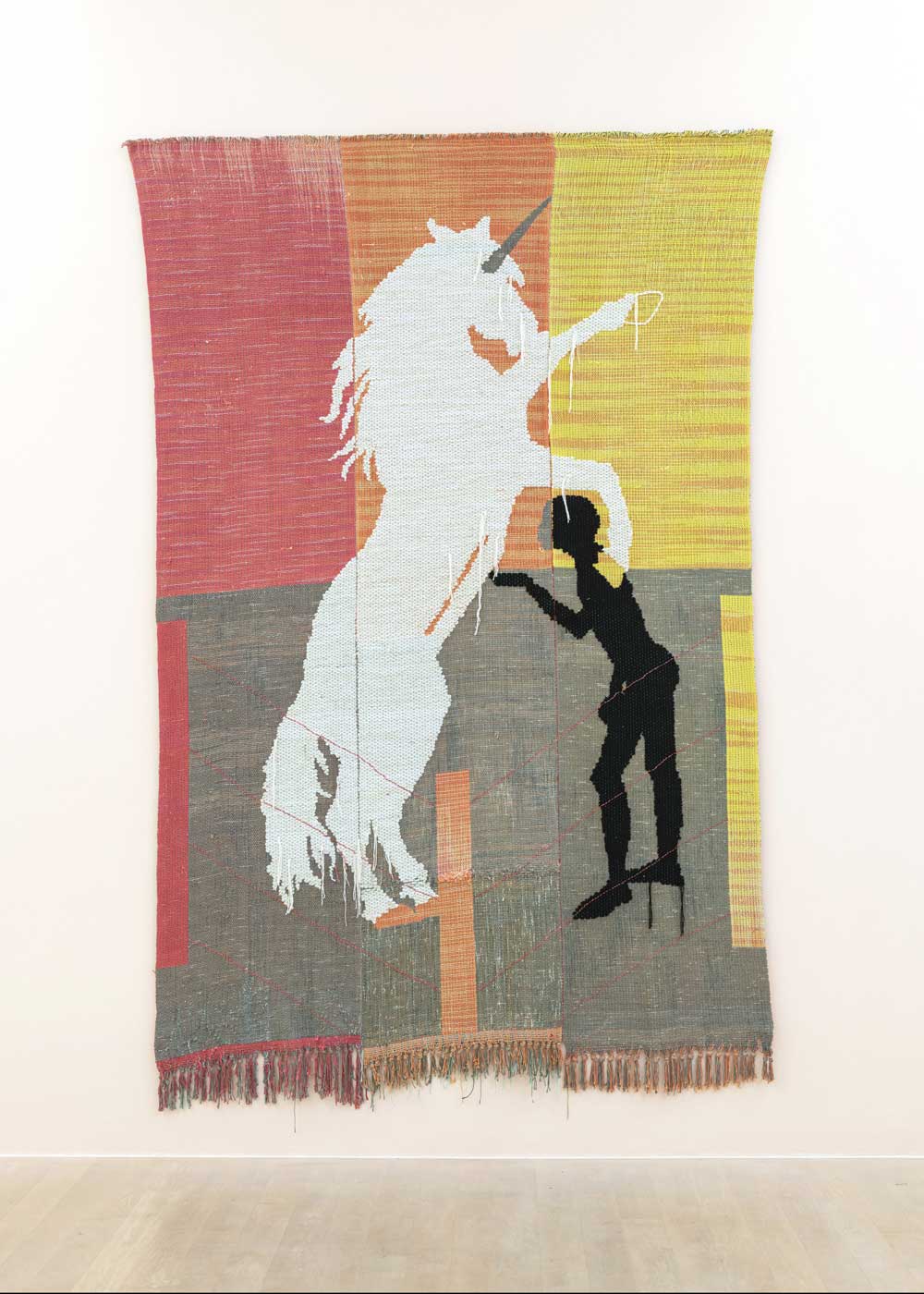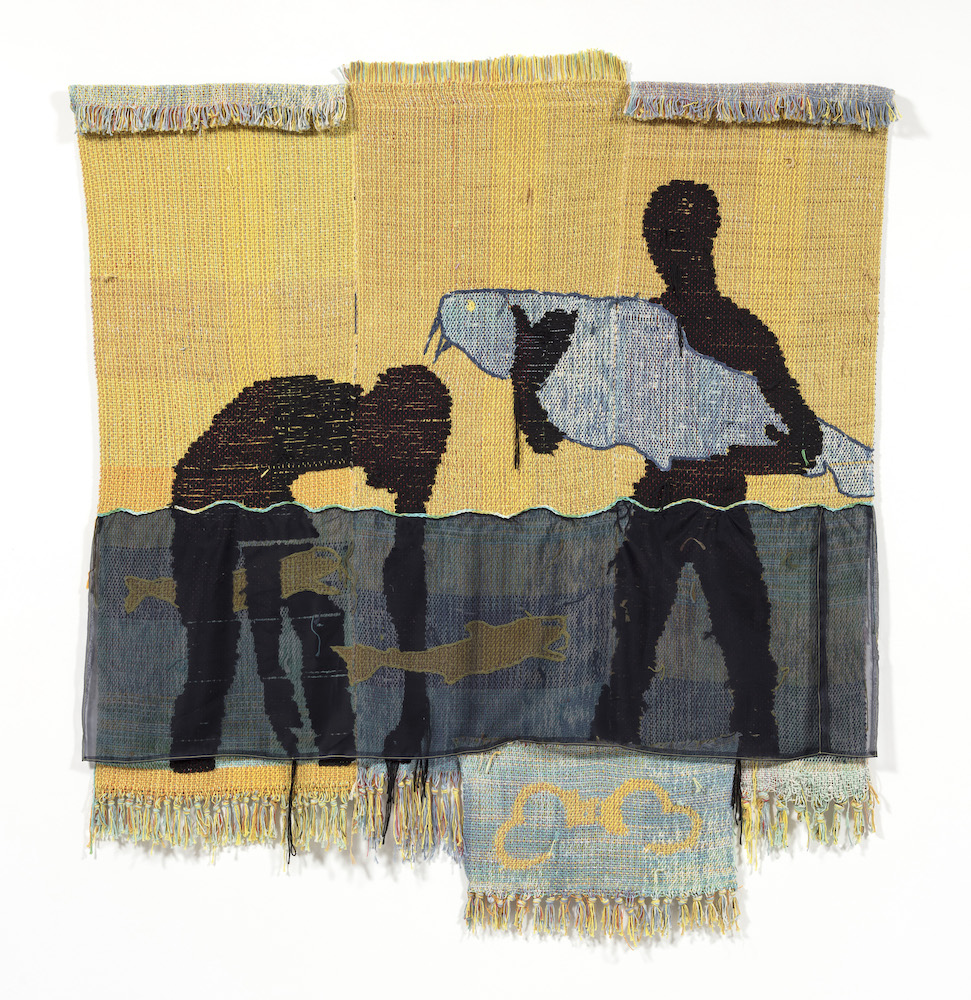Even with the growing inclusion of textile art in textbooks, surveys and biennials, one doesn’t normally think of weaving as a cutting-edge contemporary art medium. Diedrick Brackens is out to change that. A breakout star of the 2018 Hammer “Made in L.A.” biennial, Brackens uses his works to foreground Black and queer bodies—and the occasional catfish—through lyrical, at times haunting, scenarios. An eager advocate of his adopted medium—“At the very beginning I fell in love with how meditative it was,” he recalls—he is unafraid to adjust his practice through insights that he gleaned from studying painting and other art forms: first at the University of North Texas, where he was often the sole male textile artist amidst 40 women, then at California College of the Arts in San Francisco, where he got his MFA. Informed by a widely diverse range of artists, from Donald Moffett to Simone Leigh, from Sam Gilliam to Matisse, he weaves a shadow theater of allusive vignettes that examine such subjects as loss and joy, commemoration and redemption. Embracing the idioms of textile art, he extends them in invigorating new directions, with works that hover in the mind’s eye like a memory or a mirage.
“I do identify as a weaver when I’m asked what I do, or what I make,” Brackens explains. “I’m a weaver. But I feel confident about straddling the line and pushing toward a multiplicity of voices and identities. I think that, about fiber in particular, it’s one of the fields of art where there are many types of people making the work. Being Black, being queer and working in a medium that’s been disregarded, in some ways I feel very fully that this is my inheritance.”

Diedrick Brackens, demigod, 2019. Courtesy of the artist, Jack Shainman Gallery, New York and Various Small Fires, Los Angeles, Dallas and Seoul.
Although he’s known for his dramatic use of silhouetted Black figures, the route to his current approach was circuitous. Initially, Brackens abandoned figuration when critiques would wander into discussions of slavery and other issues that he hadn’t intended. After working in abstraction for a few years, he began reintroducing bodies in the tumultuous year of 2015. At first, he said, “I just wanted to see a body at rest. Then I was like, ah, there’s always only one person. That person seems so lonely.” So he gradually added in companions.
Among the central themes in his work is the use of water, which was partially inspired by the 2016 film Moonlight, with its poetic depictions of its young Black protagonist. A more sobering influence was a harrowing event that occurred in his hometown of Mexia, Texas, amidst the city’s Juneteenth celebration in 1981, before Brackens was born: three Black teens were arrested for marijuana possession, but drowned while being rowed across the town’s central lake in police custody. As a form of remembrance and perhaps transcendence, Brackens re-envisioned the boys as catfish. In what has subsequently become his signature work, bitter attendance, drown jubilee (2018)—included in the 2018 “Made in L.A.” biennial—he portrays two figures gently gathering the catfish in an image of striking sensuality, vulnerability and tenderness.

a deep and abiding dance, 2021. Courtesy of the artist, Jack Shainman Gallery, New York and Various Small Fires,
Los Angeles, Dallas and Seoul.
A focus of his 2022 solo show at Craft Contemporary, titled “heaven is a muddy riverbed,” the catfish have remained a frequent motif. Though derided as bottom feeders, catfish are in fact resilient creatures, and a staple of Southern diet and culture. Brackens is also fascinated by “other animals that we find ugly, or scavengers, because of the ways that folks of color have been animalized throughout history.” He likes to include animals that have been maligned—“animals that we find undesirable, irredeemable, like catfish, mosquitoes, pigs, goats, snakes. Yeah, if people aren’t into them, I’m usually like: They can be redeemed! They can be saved! They’re special!”

Diedrick Brackens, to soothe a myth, 2022. Diedrick Brackens, ward no. 1 second skin, 2020. Courtesy of the artist, Jack Shainman Gallery, New York and Various Small Fires, Los Angeles, Dallas and Seoul.
A recent exhibition/residency at Dartmouth College included various works with horses, and even a unicorn, inspired by such disparate references as the Four Horsemen of the Apocalypse and Assateague ponies. (Unicorns also figure prominently in several Medieval tapestries.) He deliberately avoided allusions to war or the American West. Evoking ancient myths, fables and personal allegory, the imagery feels at once dreamlike and ritualistic.
A visit to Brackens’ studio in Downtown LA offers an immersion in the tools of his craft. Across the floor is a large work-in-progress with a black silhouetted figure and a lighthouse, while a pair of looms he purchased from his old college stand by the windows. Piles of lustrous colored thread lie stacked against the walls like an installation by fabric-art pioneer Sheila Hicks. Another space holds six more looms, all of which feature weavings in various stages of tantalizing incompletion. Arrayed with rows of brightly colored string, they seem joyfully prismatic. Sitting behind one of the looms, Brackens begins to work the shuttle with the ease and dexterity of a skilled pianist.

The artist in his studio. Photo: George Melrod.
“I start any project with about 70% of what I think the image will look like,” he reflects. “And I dye the threads myself, so I’m always inviting
another chance element.” While the work is largely planned out in advance, Brackens welcomes accident and improvisation into his process. “It’s kind of like woo-woo spiritual, maybe, but I think the loom is doing as much as I’m doing. So it’s like we’re participating in the thing together.”
Physically, the works are deliberately imperfect, often featuring dangling strands of string along their tops and bottoms, with separate, often uneven, panels sewn together to create a slightly ragtag whole. Thus he literally lets the seams show, reveling in their ungainly grace. This effect leaves the works feeling loose and a bit raw, mirroring the vulnerability of his imagery. In the realm of traditional textiles this embrace of materiality and imperfection is considered radical.

Diedrick Brackens, ward no. 1 second skin, 2020. Courtesy of the artist, Jack Shainman Gallery, New York and Various Small Fires, Los Angeles, Dallas and Seoul.
This past August, Brackens curated a show at Various Small Fires, the LA gallery that represents him. Titled “Shaping Color,” it featured six diverse artists who explore the fusion of color and materiality while questioning the traditional intent of their respective mediums. This fascination with undermining expectation and expanding the language of his medium is one the artist clearly includes in his own work.
“When I think about weaving in particular, I definitely have bones to pick, things to change. There’s so much more terrain for people coming along beside and after me to take. For me, it’s exciting to be any part of that sea change,” he states. “I want to be part of defining where the medium is—where it’s going … I want to cheerlead, I want to instruct, I want to ask questions,” Brackens adds. “But I also want to trouble the idea of what mastery looks like, what excellence is—what craftmanship means.”


